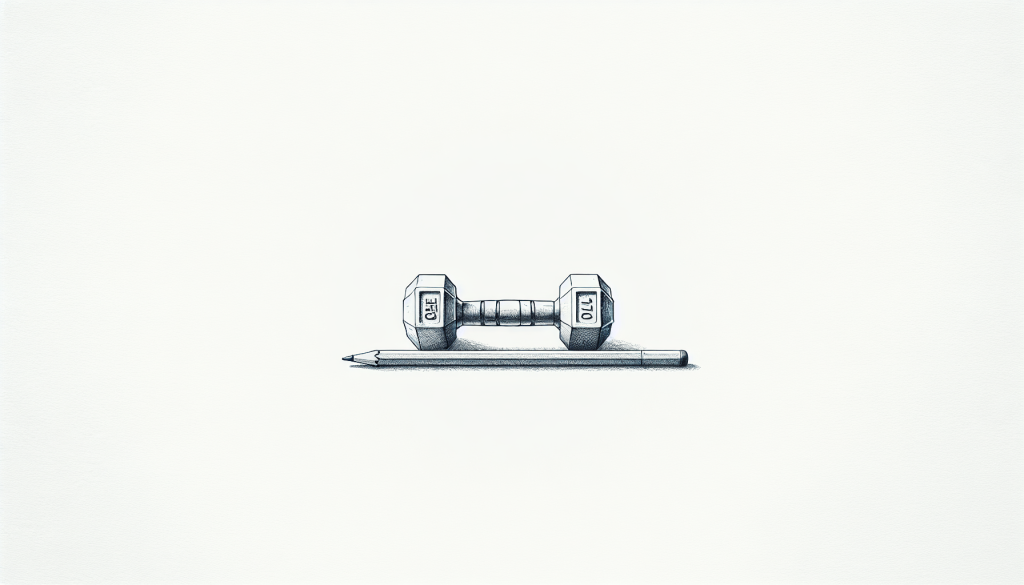Are you eager to build six pack abs and strengthen your core muscles, but find yourself unsure how to navigate the delicate balance between progressive overload and the risk of injury in your ab workouts? This common concern often plagues fitness enthusiasts like yourself, who strive to continuously challenge their bodies while avoiding potential harm. Balancing the need for progressive overload, which involves gradually increasing the demands on your muscles, with the risk of injury requires a thoughtful approach that takes into account your fitness level, proper form, and the importance of rest and recovery. In this article, we will explore effective strategies and expert tips to help you strike the perfect harmony between pushing your limits and safeguarding your body during ab workouts.
Understanding Progressive Overload
What is progressive overload?
Progressive overload is a fundamental principle in strength training that involves gradually increasing the demands placed on the muscles to stimulate growth and improve overall strength and endurance. It refers to the practice of progressively increasing the intensity, duration, or volume of an exercise over time, challenging your muscles to adapt and become stronger. By continually pushing the limits and progressively overloading the muscles, you can achieve significant improvements in your workouts and achieve your fitness goals more effectively.
Why is progressive overload important in ab workouts?
When it comes to ab workouts, progressive overload is crucial for achieving noticeable results and building a strong core. The abdominal muscles, just like any other muscle group, need to be continuously challenged to grow and become stronger. Doing the same exercises at the same intensity level will eventually lead to a plateau, where your muscles no longer respond or grow. By applying progressive overload techniques, such as increasing resistance, sets, or reps, you can ensure that the muscles in your core are constantly challenged and forced to adapt, leading to increased muscle growth and strength gains.
How does progressive overload lead to muscle growth?
Progressive overload is the key to muscle growth in ab workouts and any other type of strength training. When you progressively increase the demands placed on your muscles, you create microscopic damage and stress to the muscle fibers. In response to this stress, your body initiates a process called muscle protein synthesis, where new muscle proteins are built to repair and strengthen the damaged muscle fibers. Over time, with regular progressive overload, the muscles adapt and grow larger and stronger to handle the increased workload. This process is essential for achieving noticeable improvements in your ab workouts and developing a more defined and muscular core.
Understanding the Risk of Injury in Ab Workouts
Common injuries in ab workouts
Ab workouts, especially those involving intense movements or incorrect form, can pose a risk of injury if proper precautions are not taken. Some common injuries associated with ab workouts include:
-
Strains and pulls: Overexertion or improper technique can result in strains or pulls in the abdominal muscles, which can cause pain and restrict your range of motion.
-
Lower back injuries: Many ab exercises also engage the lower back muscles. If these exercises are performed incorrectly or with excessive weights, it can lead to strains or sprains in the lower back region.
-
Hernias: Certain abdominal exercises that involve intense straining or improper breathing techniques can increase the risk of developing hernias, which occur when an organ pushes through a weak spot in the muscle or surrounding tissue.
Factors that contribute to the risk of injury in ab workouts
Several factors contribute to the risk of injury in ab workouts. It’s essential to be aware of these factors and take appropriate measures to minimize the risk:
-
Lack of proper warm-up: Failing to warm up adequately before ab workouts can increase the risk of muscle strains and pulls. Spending a few minutes performing dynamic stretches and light cardio exercises can help prepare the muscles and reduce the risk of injury.
-
Incorrect form and technique: Using incorrect form while performing ab exercises can place unnecessary strain on the muscles and joints, increasing the risk of injury. It’s crucial to learn proper form and technique and concentrate on maintaining correct alignment and engaging the targeted muscles effectively.
-
Overtraining and lack of rest: Overtraining without giving your muscles sufficient time to recover increases the risk of overuse injuries in the abdominals and other supporting muscles. It’s vital to incorporate rest days into your workout routine and listen to your body’s signals for adequate recovery.

Finding the Right Balance
Assessing your current fitness level
Before embarking on any ab workout program, it’s crucial to assess your current fitness level to ensure you set realistic goals and avoid pushing yourself too hard. Some ways to assess your fitness level include:
-
Strength tests: Performing exercises like planks or sit-ups and noting how long you can hold them or how many reps you can complete can give you an idea of your current abdominal strength.
-
Flexibility assessment: Testing your flexibility through exercises like the seated forward fold can help identify areas that may need improvement.
-
Endurance evaluation: Timing how long you can maintain a steady ab-focused workout or how many sets and reps you can complete without exhaustion can give insight into your current stamina.
Consulting a fitness professional
If you’re unsure about how to balance progressive overload and injury prevention in your ab workouts, consulting with a fitness professional can be immensely beneficial. They can assess your individual needs, provide expert guidance on proper exercise selection and form, and develop a personalized plan that effectively incorporates progressive overload while minimizing the risk of injury. A fitness professional can also help you track your progress and make adjustments as needed, ensuring that you continue to see steady improvements in your abdominal strength and muscle definition.
Listening to your body
Listening to your body is a vital aspect of finding the right balance between progressive overload and injury prevention. Your body provides valuable feedback signals, such as muscle soreness, fatigue, or discomfort, that can guide your workouts.
Pay attention to how your body responds to different exercises, weights, or intensity levels. If you experience excessive pain, sharp discomfort, or persistent soreness that doesn’t subside after a few days, it may indicate the need to modify your routine or seek medical advice. On the other hand, if you feel energized, challenged, and notice steady progress, it’s a positive indication that you are finding the right balance and effectively incorporating progressive overload into your ab workouts.
Progressive Overload Techniques
Increasing resistance or weight
One of the most effective ways to apply progressive overload in ab workouts is by gradually increasing the resistance or weight used in your exercises. This can be done by using tools such as dumbbells, medicine balls, resistance bands, or weight machines specifically designed for targeting the abdominal muscles.
Start with a comfortable weight that allows you to perform the exercises with proper form and complete the desired number of reps with some effort. As your strength improves, incrementally increase the weight or resistance to continue challenging your muscles and promoting further progress.
Adding more reps or sets
Another way to implement progressive overload in your ab workouts is by gradually increasing the number of reps or sets performed. Once you can perform an exercise with proper form and the targeted muscle group is adequately fatigued by the current number of reps or sets, consider adding one or two more repetitions or an extra set.
For example, if you are currently performing three sets of 10 reps for a particular exercise, you can gradually increase it to four sets of 10 reps, or maintain three sets but increase the reps to 12. This gradual increase in volume will stimulate further muscle adaptation and growth.
Changing exercise intensity or difficulty
Varying the intensity or difficulty of your ab exercises is another effective progressive overload technique. Instead of sticking to the same routine, continuously challenge your muscles by incorporating more advanced variations of exercises or increasing the intensity of your movements.
For example, if you have mastered traditional crunches, you could progress to exercises like bicycle crunches, Russian twists, or plank variations such as side planks or stability ball planks. These exercises engage different muscle fibers and increase the demand placed on your core, promoting further improvements and avoiding stagnation.

Injury Prevention Strategies
Proper warm-up and cool-down
To reduce the risk of injury in ab workouts, it’s important to prioritize proper warm-up and cool-down routines. Before starting your abdominal exercises, spend 5-10 minutes engaging in light cardio exercises, such as jogging or jumping jacks, to increase blood flow to the muscles and prepare them for the upcoming workout. Follow this with dynamic stretches that target the abdominal muscles and surrounding areas.
After completing your ab workout, take a few minutes to cool down by performing static stretches that focus on the abs and other muscle groups involved. This can help prevent muscle tightness and promote better recovery.
Using correct form and technique
Using correct form and technique is crucial for preventing injuries during ab workouts. Improper alignment or excessive strain on the muscles and joints can lead to overuse injuries or strains.
Take the time to learn and practice the proper form for each exercise. Focus on engaging the abdominal muscles throughout the movement, keeping the spine aligned, and avoiding jerky or abrupt motions. Consider working with a fitness professional or referring to reputable online resources for guidance on proper form and technique for various ab exercises.
Engaging in core-strengthening exercises
In addition to ab-specific exercises, incorporating core-strengthening exercises into your routine can help prevent injuries during ab workouts. The core consists of more than just the abdominal muscles; it also includes the muscles in your back, hips, and pelvis. Strengthening these muscles provides a stable foundation and better support for your spine during ab exercises.
Exercises such as planks, deadlifts, bridges, and bird dogs are valuable additions to your workout routine as they engage multiple core muscles simultaneously. By strengthening your entire core, you can improve stability, reduce the risk of injury, and enhance overall performance in your ab workouts.
Monitoring Your Body’s Response
Recognizing signs of overexertion or strain
It’s important to be aware of the signs of overexertion or strain during ab workouts to prevent injuries. Some common signs to watch out for include:
-
Severe or sharp pain: If you experience sharp or intense pain during an exercise, it’s crucial to stop immediately and assess the situation. Pushing through severe pain can lead to further injury.
-
Excessive muscle fatigue: Feeling excessively fatigued or unable to maintain correct form, even after proper rest and recovery, may indicate that you’re overworking your muscles. It’s essential to listen to your body and modify your routine accordingly.
-
Decreased range of motion: If you notice a significant decrease in your range of motion or find it challenging to perform exercises that were previously comfortable, it could indicate that your muscles are fatigued and need more rest.
Adjusting workout intensity based on feedback
Listening to your body’s feedback is essential in adjusting your workout intensity appropriately. If you consistently experience excessive muscle soreness, fatigue, or lack of progress, it may be a sign that you need to adjust the intensity of your ab workouts.
Consider reducing the resistance, number of sets or reps, or even taking extra rest days to allow your muscles to recover fully. On the other hand, if your workouts have become relatively easy or you’re no longer feeling challenged, it may be time to increase the intensity or move on to more advanced exercises.
Taking rest days and recovery periods
Rest is an integral part of any effective workout routine, including ab workouts. Your muscles need time to repair and rebuild after each workout to prevent overuse injuries and promote optimal growth. Incorporating rest days into your routine enables your body to recover fully, recharge, and come back stronger.
Listen to your body’s signals for rest. If you feel excessively fatigued, sore, or notice a decline in performance, it’s an indication that you may need to take an additional rest day or prioritize active recovery exercises such as light jogging, swimming, or gentle stretching.

Understanding Exercise Progression
Gradually increasing workout intensity
Exercise progression involves gradually increasing the intensity of your workouts over time to continue challenging your muscles. This ensures that you don’t hit a plateau and keep making progress in your ab workouts.
Instead of trying to do too much too soon, start with a moderate intensity level and gradually increase it as you become more comfortable and stronger. Monitor your progress, adjust the intensity accordingly, and aim to slightly exceed your previous workout’s demands to promote ongoing improvements in your abdominal strength and muscle growth.
Introducing new exercises progressively
Adding variety to your ab workouts is essential not only to keep things interesting but also to continue stimulating muscle growth and adaptation. Introducing new exercises progressively allows your muscles to experience different types of stimuli and prevents the body from getting too accustomed to a particular routine.
Start by mastering the basics of ab exercises, such as crunches, planks, and leg raises, and gradually incorporate more challenging variations as you become comfortable with the movements. This progressive approach helps ensure proper form and minimizes the risk of injury while promoting continuous progress and overall growth.
Evaluating progress and making adjustments
Regularly evaluating your progress is an essential aspect of exercise progression. It enables you to gauge the effectiveness of your training program, identify areas of improvement, and make necessary adjustments to optimize your ab workouts.
Keep track of key indicators of progress, such as increases in weight or resistance, improvements in the number of reps or sets completed, or the ability to perform more challenging exercises. Assess your overall strength and muscle definition regularly and adjust your workout routine, intensity, or exercise selection accordingly to maintain consistent progress.
Importance of Recovery and Rest
Allowing muscles time to repair and grow
Recovery and rest are essential for achieving optimal results in ab workouts. When you work out, you create micro-tears in your muscles, which need time to repair and regenerate stronger than before. Allowing your muscles sufficient time to rest and recover is vital for the muscle-building process.
During rest and recovery periods, the damaged muscle fibers heal and rebuild, resulting in increased muscle size and strength. Neglecting rest days can lead to overtraining, reduced progress, increased risk of injury, and overall fatigue. Prioritize recovery as an essential part of your fitness routine to maximize the benefits of your ab workouts.
Incorporating rest days into your workout routine
Including rest days in your workout routine is crucial to give your muscles time to recover and adapt to the stress placed on them during ab workouts. Rest days allow your muscles and connective tissues to repair, reducing the risk of overuse injuries and preventing the accumulation of fatigue.
Consider incorporating one to three rest days per week, depending on your individual needs and fitness level. Use these rest days to engage in other forms of active recovery, such as light cardio exercises, stretching, or foam rolling, to promote circulation and enhance overall recovery.
Including active recovery exercises
Active recovery exercises can play a significant role in promoting muscle recovery and reducing the risk of injury in ab workouts. These exercises are low-intensity and focus on improving blood flow, reducing muscle soreness, and enhancing overall mobility.
Engaging in activities such as gentle yoga, swimming, cycling, or walking can stimulate circulation and promote the removal of metabolic waste products from the muscles. By incorporating active recovery exercises into your routine, you can aid in muscle repair, enhance flexibility, and prepare your body for upcoming workouts.

Listening to Your Body’s Limitations
Recognizing pain versus muscle soreness
Distinguishing between pain and muscle soreness is crucial when it comes to ab workouts. Muscle soreness is a common and normal response to physical exertion and typically occurs within 24-48 hours after intense exercise. It feels like a dull, achy sensation in the muscles and should gradually decrease over time.
Pain, on the other hand, is a sharp or intense sensation that feels abnormal and persists even after adequate rest and recovery. If you experience sharp pain during or after an ab workout, it’s important to stop immediately and assess the situation. Pushing through pain can lead to further injury, and seeking medical advice is recommended.
Modifying exercises to avoid pain or discomfort
If you notice pain or discomfort during specific ab exercises, it’s essential to modify them to avoid further aggravation or injury. Many exercises have alternative variations or modifications that can target the same muscle group with reduced strain.
For example, if traditional crunches cause lower back pain, you can try performing reverse crunches or leg lifts, which place less stress on the lower back. Experiment with different exercises and techniques to find what works best for your body and allows you to perform ab workouts comfortably and safely.
Seeking medical advice when necessary
While most ab workouts can be safely performed by individuals of different fitness levels, it’s important to seek medical advice when necessary. If you have any pre-existing medical conditions or concerns about engaging in ab workouts, consult with a healthcare professional before starting a new exercise program.
Certain conditions, such as hernias, diastasis recti, or lower back injuries, may require modified exercises or specific precautions to prevent further complications. A healthcare professional can provide guidance tailored to your specific needs and ensure that you engage in safe and effective ab workouts.
Incorporating Variety Into Your Ab Workouts
Trying different exercises and equipment
Incorporating variety into your ab workouts not only keeps things interesting but also ensures that different muscle fibers are engaged and challenged. Trying different exercises and equipment can promote muscle growth and prevent the body from adapting and plateauing.
Explore a wide range of ab exercises, such as planks, bicycle crunches, V-ups, Russian twists, or reverse crunches, to target different areas of the core and stimulate muscle growth. Additionally, incorporating equipment such as stability balls, resistance bands, or medicine balls can introduce new challenges and intensify your ab workouts.
Alternating between different ab workout routines
To avoid monotony and continually challenge your muscles, alternate between different ab workout routines. Designate specific days or weeks to focus on specific areas of the core or types of exercises.
For example, you can dedicate one day to work on upper abs, another day for lower abs, and another day for obliques. Alternatively, you can follow a HIIT (High-Intensity Interval Training) approach, alternating between periods of high-intensity ab exercises and short rest intervals. This variety not only keeps your workouts fresh but also helps you continuously progress and achieve greater results.
Joining group fitness classes or hiring a personal trainer
Joining group fitness classes or hiring a personal trainer can be an excellent way to incorporate variety into your ab workouts and ensure proper form and technique. Group fitness classes, such as Pilates, yoga, or boot camps, offer a wide range of exercises and expert guidance, while personal trainers can provide individualized attention and design tailored routines.
Working out in a group setting or with a qualified instructor can provide new perspectives, motivation, and accountability, making your ab workouts more enjoyable and effective. Additionally, the expertise of a fitness professional can help you avoid injury, navigate the intricacies of progressive overload, and continuously challenge and refine your ab workouts.
In conclusion, achieving a balance between progressive overload and preventing the risk of injury is crucial for effective and safe ab workouts. By understanding the principles of progressive overload, being aware of the common injuries and risk factors, and implementing injury prevention strategies, you can maximize the benefits of your ab workouts while minimizing the chances of injury. Listen to your body, adapt your workouts to your fitness level, and consider seeking guidance from a fitness professional to ensure optimal progress and results. Incorporating variety, active recovery exercises, and rest days will further enhance your ab workouts and contribute to your overall fitness and well-being. Keep striving, stay motivated, and enjoy the journey to a stronger and more defined core!






